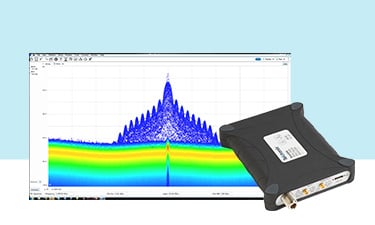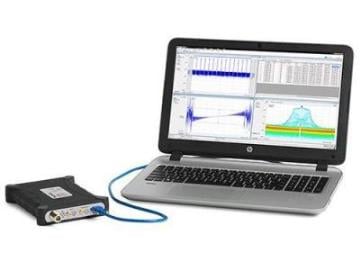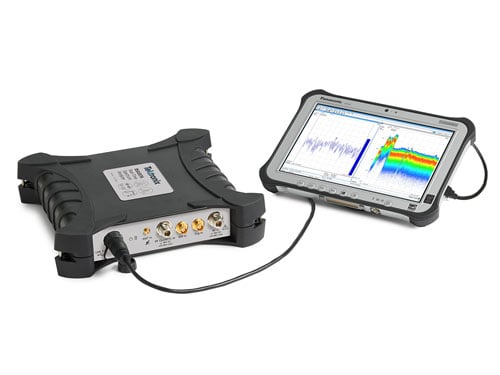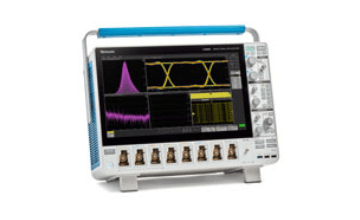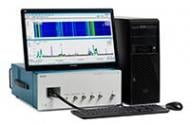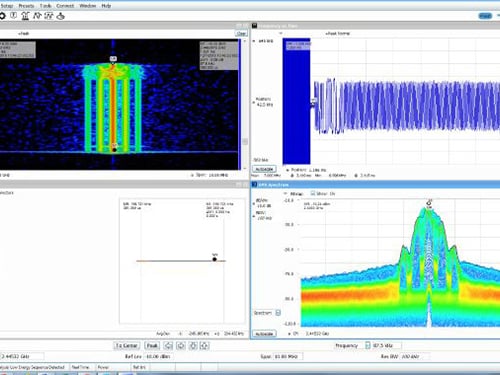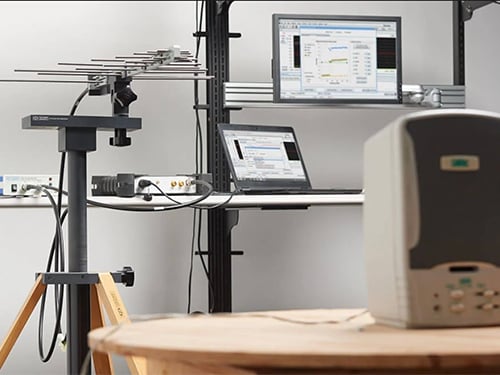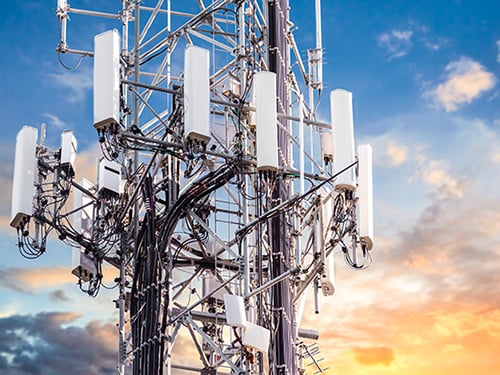연락처
텍트로닉스 담당자와 실시간 상담 6:00am-4:30pm PST에 이용 가능
전화 문의
9:00am-6:00PM KST에 이용 가능
다운로드
매뉴얼, 데이터 시트, 소프트웨어 등을 다운로드할 수 있습니다.
피드백
무선 주파수 테스트의 이해: 무선 시스템 성공의 열쇠
무선 주파수(RF) 테스트는 무선 통신 및 방송에서 레이더 및 위성 시스템에 이르기까지 다양한 응용 분야에서 신호를 전송하는 데 사용되는 전자기파를 측정하고 분석하는 과정입니다. RF 테스트는 이러한 신호의 성능, 강도 및 품질을 평가하여 특정 표준 및 요구 사항을 충족하는지 확인합니다. 이는 무선 통신 및 감지 시스템의 기능과 신뢰성에 영향을 미칠 수 있는 문제를 식별하는 데 도움이 되므로 RF 부품 및 시스템의 개발, 검증 및 유지 관리에 필수적입니다. 또한 RF 테스트는 전자기 호환성(EMC)을 보장하여 방출 및 간섭에 대한 내성을 모두 다룹니다. 이는 간섭을 방지하고 전자 장치가 주변 환경에서 조화롭게 작동할 수 있게 하는 데 매우 중요합니다.
RF 테스트란 무엇입니까?
RF 테스트는 무선 통신 시스템 및 전자 장치의 최적 성능과 신뢰성을 보장하는 데 매우 중요합니다. 종합적인 RF 테스트를 수행함으로써 엔지니어는 신호 무결성, 간섭 및 전반적인 시스템 효율성과 관련된 문제를 감지하고 해결할 수 있습니다. 이를 통해 무선 구성 요소 및 시스템의 품질과 기능을 향상시킬 뿐만 아니라 산업 표준 및 규정 요구 사항을 준수할 수 있습니다. 효과적인 RF 테스트는 고장 나서 비용이 많이 들 가능성을 최소화하고, 운영 효율성을 극대화하며, 무선 기술이 실제 조건에서 예상대로 작동할 것이라는 확신을 제공합니다. 궁극적으로 RF 테스트는 일상적인 가전 제품에서 특수 산업 장비에 이르기까지 무선 주파수에 의존하는 장치를 개발, 인증 및 유지 관리하는 데 매우 중요하며, 기업이 오늘날의 고도로 연결된 세계에서 경쟁 우위를 확보하는 데 도움이 됩니다.
주파수(스펙트럼) vs. 시간 도메인 분석
주파수(스펙트럼)와 시간 도메인 분석의 차이점과 유사점을 이해하는 것은 효과적인 무선 주파수(RF) 테스트에 매우 중요합니다. 각 도메인은 고유한 인사이트를 제공하며 규제된 주파수 할당 내에서 무선 통신의 적절한 기능을 최적화하고 보장하는 데 사용됩니다.
주파수(스펙트럼) 도메인 분석
정의: 주파수(스펙트럼) 분석은 전자기 신호의 주파수 스펙트럼을 평가하여 진폭, 주파수 및 위상과 같은 특성을 식별하고 측정하는 프로세스입니다. 스펙트럼 분석기를 사용하여 엔지니어는 신호 간섭, 스퓨리어스 방사 및 고조파와 같은 문제를 감지하고 진단할 수 있습니다. 스펙트럼 분석을 통해 주어진 대역폭 내에서 다양한 신호 소스를 정확하게 식별할 수 있으므로 시스템이 원치 않는 방해 없이 효율적으로 작동할 수 있습니다. 이는 무선 통신 시스템, 방송 장비, 레이더 및 기타 RF 애플리케이션의 개발, 테스트 및 유지보수를 위한 기본 도구입니다.
사용 사례: 스펙트럼 분석은 셀룰러 네트워크 및 무선 통신, 방송, 레이더 및 방위, 항공우주, 의료 기기, R&D, 규정 준수 테스트 및 산업 응용 분야를 포함한 여러 산업에서 매우 중요합니다. 전자기 스펙트럼은 ITU, FCC, EU와 같은 다양한 조직에서 엄격하게 규제되기 때문입니다. 장치가 이러한 규정을 준수하도록 보장하고, 스펙트럼을 효율적으로 관리하며, 간섭의 원인을 식별하는 데 도움을 줍니다.
과제와 솔루션: 주파수 분석은 점점 더 혼잡해지는 주파수 대역 관리, 신호 간섭 식별 및 완화, 복잡한 환경에서의 정확한 측정 보장 등 몇 가지 주요 과제에 직면해 있습니다. 또한 엔지니어는 무선 기술의 빠른 진화에 대응해하여 테스트 방법론과 장비를 지속적으로 업데이트해야 합니다. 또한, 신호 성능을 최적화하면서 엄격한 규제 기준을 준수하는 것도 또 다른 복잡성을 추가합니다. 이러한 문제는 신뢰할 수 있고 효율적인 RF 시스템 운영을 보장하기 위해 고급 장비와 소프트웨어가 필요합니다.
시간 도메인 분석
정의: 시간 도메인 분석은 RF 신호가 시간에 따라 어떻게 변하는지를 조사하며, 주로 위상, 진폭 및 주파수의 변화를 중심으로 합니다. 이는 신호의 동적 특성에 대한 인사이트를 제공합니다.
사용 사례: RF 신호의 시간 도메인 분석은 일시적인 이벤트와 비반복 신호 동작을 실시간으로 캡처하고 분석할 수 있는 능력을 포함하여 여러 가지 주요 장점을 제공합니다. 이 방법은 신호 진폭, 위상 및 타이밍 특성에 대한 인사이트를 자세하게 제공하여 RF 시스템의 정확한 문제 해결과 최적화가 가능합니다. 시간 도메인 분석은 패스트 라이징 에지, 펄스 신호, 위상 고정 루프, 주파수 정착 및 동기화 문제를 식별하는 데 특히 효과적입니다.
도전 과제와 솔루션: 시간 도메인의 주요 과제는 빠르게 변화하는 신호를 정확하게 감별하는 것이며, 이는 첨단 통신 시스템과 레이더 기술에서 매우 중요합니다. 고대역, 시간 도메인 분석은 시간의 작은 변화까지도 정확하게 캡처하고 이를 주파수 도메인에서 신호의 동작과 상관시켜 이를 해결하는 데 도움이 됩니다.
무선 주파수 테스트(RF 테스트)를 위한 중요한 도구 및 시스템
RF 테스트는 무선 통신 및 감지 장치의 성능과 효율성을 보장하는 데 매우 중요합니다. 당사는 실시간 스펙트럼 분석기, 오실로스코프, 임의 파형 발생기 등 RF 테스트에 사용되는 필수 도구에 대해 중점적으로 다루며, 각각이 테스트 과정에서 고유한 역할을 합니다.
무선 주파수 테스트용 하드웨어 및 시스템
실시간 스펙트럼 분석기(RSA)
주요 특징:
- 고속 성능: RSA는 고대역폭 RF 신호의 빠르고 끊김 없는 캡처 및 분석을 위해 설계되었습니다.
- 실시간 기능: 기존 스펙트럼 분석기와 달리 RSA는 순간 대역폭 내에서 실시간으로 신호를 처리하므로 다른 계측기가 놓칠 수 있는 일시적인 이벤트를 캡처할 수 있습니다. 이는 복잡한 통신 및 레이더 신호에 대한 철저한 분석을 가능하게 합니다.
애플리케이션: RSA는 동적 무선 신호 테스트 및 복잡한 간섭 시나리오와 같이 속도와 정확성이 중요한 환경에서 없어서는 안 될 필수 요소입니다.
일반적인 사용:
- 실험실 환경: RSA는 일반적으로 무선 기술을 위한 새로운 구성 요소와 시스템을 개발하는 R&D 연구소에서 사용됩니다. 연구소에서는 빠르게 움직이는 이상 징후와 가짜 신호를 감지하는 데 실시간 분석이 중요합니다.
- 제조 시설(Fab): 제조 테스트에서 RSA는 제품이 요구되는 RF 및 방출 사양을 충족하는지 확인하고 최종 사용자에게 전달되기 전에 RF 전력을 교정하는 데 도움을 줄 수 있습니다.
- 현장 테스트: 엔지니어는 특히 레이더, 통신 및 방송 분야에서 현장 진단, 문제 해결 및 현장 시스템 검증을 위해 휴대용 RSA를 사용합니다.
오실로스코프
주요 특징:
- 다양한 대역폭 옵션: 몇 MHz에서 수 GHz의 순간 대역폭까지 다양합니다.
- 멀티채널 모델: 2채널, 4채널 및 최대 8채널 구성으로 제공되어 여러 신호를 동시에 모니터링할 수 있는 기능이 향상되었습니다.
애플리케이션: 오실로스코프는 전자 신호의 시간 도메인 특성에 대한 자세한 분석에 필수적이며, 특히 디버깅 및 신호 무결성 검사를 위한 연구 개발 환경에서 유용합니다.
일반적인 사용:
- 실험실 환경: 전자 신호의 타이밍 동작에 대한 연구, 개발 및 검증에 필수적입니다.
- 제조 시설(Fab): 전자 설계 및 시스템이 생산 중 촉박한 시간 기준을 충족하는지 확인하는 데 사용됩니다.
- 현장 테스트: 휴대용 모델은 통신 인프라 현장과 같은 실제 운영 환경에서 문제를 진단하고 해결하는 데 사용됩니다.
임의 파형 발생기(AWG)
주요 특징:
- 유연성: AWG는 단일 발생 또는 반복적인 신호로 특정 테스트 조건에 맞게 조정된 모든 파형을 생성할 수 있는 탁월한 기능을 제공합니다.
애플리케이션: AWG는 복잡한 파형을 시뮬레이션하고 다양한 신호 조건에서 장치 응답을 테스트하는 데 특히 유용하며, 견고하고 효율적인 무선 장치 개발에 도움이 됩니다.
일반적인 사용:
- 실험실 환경: 다양한 신호 시나리오를 시뮬레이션하고 분석하기 위해 설계 및 테스트 단계에서 널리 사용됩니다.
- 제조 시설(Fab): 최종 제품 기능을 검증하고 현실적인 조건에서 스트레스 테스트를 수행하는 데 중요합니다.
- 현장 테스트: 실제 환경에서 시스템 응답을 테스트하는 데 필요한 특정 신호를 현장에서 생성하는 데 유용합니다.
RF 테스트 소프트웨어 개요
소프트웨어는 고급 신호 처리, 분석 및 시뮬레이션 기능을 통해 하드웨어의 기능을 향상시키며 RF 테스트에서 중요한 역할을 합니다.
주요 특징:
- 신호 분석: 소프트웨어 툴은 광범위한 분석 결과를 제공하여 엔지니어가 스펙트럼 활용, 신호 변조 품질, 시스템 안정성 및 성능을 이해하는 데 도움을 줍니다.
- 시뮬레이션 기능: RF 테스트 소프트웨어는 복잡한 무선 환경 및 신호 상호 작용을 시뮬레이션하여 엔지니어가 실제 상황에서 장치가 어떻게 작동할지 예측할 수 있게 합니다.
- 자동화 테스트: 많은 RF 테스트 소프트웨어 패키지에는 자동화 기능이 포함되어 있어 테스트 프로세스를 간소화하고 인적 오류를 줄이며 반복성과 효율성을 높입니다.
- 데이터 관리: 효과적인 소프트웨어는 테스트 데이터를 구조직화, 저장 및 검색하는 데 도움을 주어 더 쉬운 보고 및 규정 준수를 추적할 수 있게 합니다.
애플리케이션:
- 설계 검증: 소프트웨어는 설계 단계에서 라디오 시스템의 모든 주요 RF 매개변수를 특성화하고, 사용 사례를 검증하며, 라디오 장치의 전자기 호환성과 신호 무결성을 보장하기 위해 광범위하게 사용됩니다.
- 규정 준수: 세심한 교정 및 테스트 절차를 통해 모든 무선 장치가 글로벌 통신 표준 및 규정을 충족하는지 확인합니다.
- 성능 최적화: 다양한 조건에서 최적의 RF 성능을 위해 장치를 조정하는 데 도움이 되며, 다양한 작동 매개변수 하에서 장치 동작에 대한 자세한 피드백을 제공합니다.
RF 테스트용 액세서리 및 어댑터
액세서리 및 어댑터는 RF 테스트 장비의 기능을 확장하고, 정확하고 효율적인 측정 및 분석을 보장하는 데 필수적입니다.
핵심 기능:
- 케이블 및 커넥터: 고품질 케이블 및 커넥터는 테스트 중 신호 무결성을 유지하는 데 필수적입니다. 반사 및 손실을 방지하려면 시스템의 임피던스와 일치해야 합니다.
- 신호 감쇠기: 이는 파형을 크게 왜곡하지 않고 신호 전력을 줄이는 데 사용됩니다. 감쇠기는 민감한 장비를 높은 신호 수준으로부터 보호하는 데 필수적입니다.
- 안테나: 다양한 테스트에는 신호를 정확하게 포착하거나 방출하기 위해 다양한 유형의 안테나가 필요할 수 있습니다. 안테나는 테스트에 필요한 특정 주파수와 방사 패턴을 기반으로 선택해야 합니다.
- 어댑터: 서로 다른 유형의 커넥터 및 케이블을 인터페이스하는 데 도움이 되며, 다양한 테스트 장비 간의 호환성을 보장합니다.
- 교정 키트: 적절한 교정 키트를 사용한 정기적인 교정은 RF 테스트 장비가 정확하고 일관된 결과를 제공하도록 보장하는 데 필요합니다.
애플리케이션:
- 확장된 테스트 범위: 하이게인 안테나 및 광대역 케이블과 같은 액세서리를 사용하면 더 넓은 범위의 조건과 설정에서 테스트할 수 있습니다.
- 신호 특성화: 올바른 어댑터와 케이블을 사용하면 테스트 중에 신호가 변경되지 않아 보다 정확한 특성화를 수행할 수 있습니다.
- 장치 호환성: 어댑터 및 교정 키트는 테스트 장비의 다기능성을 유지하여 광범위한 장치 및 표준과 호환하는 데 도움이 됩니다.



